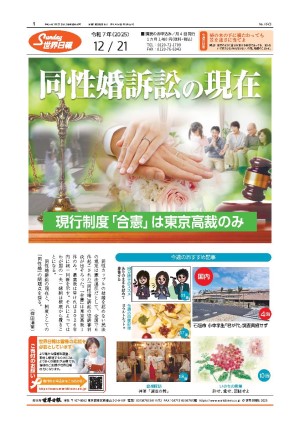危機的状況にある日本人のライフスタイル A way of life in peril
日本文化の大きなミステリーは、ほかの文化からの借用をしながら、いかに、それが独自性を保っていられるか、ということである。日本が(鎖国による)孤立からの脱却を余儀なくされた19世紀半ば以来、日本ほど大きな変化を経験した社会はほかにない。これらの変化の多くは、外国の技術や習慣を採り入れることによってもたらされた。中には、日本人のライフスタイルの最も卑近なところで、起きているのが見られる。大抵の日本人は、衣服を変え、仏教徒の菜食主義者らも、今では、お金さえあれば、おいしい神戸牛ステーキに舌鼓を打つ。
数え切れないほどの日本人が、18世紀後半の厳しい人口問題のプレッシャーの下、朝鮮および満州、ハワイ、ブラジル、ペルー、そしてまた、米国に移住していったのだが、日本に定住した外国人は極めて少なかった。大人数の朝鮮人のマイノリティーは、日本で唯一重要な移民人口となっている。生得市民権が得られないにもかかわらず、朝鮮人は大勢が同化しているのだ。
日本は、そっけなく大規模な移民の受け入れの拒絶を貫いてきている。外国人は、社会的エチケットの複雑な制限や社会の閉鎖性に順応するのに苦労している。日本語は、中国の表意文字(漢字)を、もっと最近になってからは、西側諸国の言語を借用しているので、極めて学びにくい。
ひょっとすると、日本人は、自分たちの文化圏に入って来る外国人を、ほかの社会の人たちよりも、遠慮がちに眺めているのかもしれない。欧州人や米国人は何世紀にもわたって、引きも切らずやって来る移民には慣れっこになっているのだが、日本人はそうではないのだ。
今、日本は、人口動態的危機に直面している。その人口は、2060年までに1億2700万人から8700万人に減少すると予測されている。そして、その時、人口の40%が65歳ないし、それ以上になっている。日本がこの減少を、反転させるか、食い止めることができなければ、市場の縮小、社会福祉の負担の増大、そして、莫大な公的債務などによって、この繁栄する社会はぶち壊されてしまうだろう。労働力の不足は、すでにGDP(国内総生産)の成長率を1990年代初めの3%以上からわずか0.5%に下落させる要因になっている。
米国経済と密接な連携を保つことによって、日本が世界のリーダーとしての立場を継続させることは、米国の世界戦略の重要なゴールとするところであり、また、その一環にならなければならない。現在、低成長と、予想される政治的困難の時代に入ろうとしている中国は、嫌々ながらのパートナー――そして、恐らくは、敵――にしかなれないであろうという可能性がますます強くなっている。米国は、第2次大戦以来、日本に東南アジア諸国やインドとの関係を強化するようを働き掛けてきた。それは、日本がアジアの移民に対して国の門戸を開放したら、さらに強化されるであろう。
さらなる変化が進行中かもしれない。日本のリベラルな有力紙、朝日新聞は、最近の世論調査で、日本人回答者の51%が外国人受け入れを支持しており、34%が移民の人数を拡大することに反対すると言っている、と報じている。それは、5年前の同様の世論調査の数字よりも、50%近くの同意の増加を示している。
さらに、調査に参加した日本人の半数以上が、移民を受け入れることは、日本の予想される労働力不足を解決するだろうと思うと言っている。回答者の考え方の中には、容赦のない現実主義も見られる。22%が、これ以上の移民の受け入れは、国の安全の弱体化を招くと確信すると言い、そして、54%が、多分、そうなるだろうと思う、と言った。
米国は、このことについては、言うべきことはあまりない。公式には。しかし、米国の政策立案者らは、国民感情の変化を識別し、前向きな日本人の反応を引き出すよう働き掛けなければならない。
(3月2日付)
The great mystery of the Japanese culture is how it remains unique while borrowing from other cultures. No society has undergone greater changes than Japan since the mid-19th century, when it was forced out of isolation. Many of these changes were wrought by adopting foreign technology and customs, some in the most intimate aspects of Japanese lifestyle. Most Japanese changed their clothes, and Buddhist vegetarians now enjoy a good steak, from Kobe if they can afford it.
Thousands of Japanese immigrated to Korea and Manchuria, Hawaii, Brazil, Peru and to the United States, under severe population pressure in the late 18th century, but few foreigners settled in Japan. A significant Korean minority comprises Japan’s only important immigrant population. Despite a lack of citizenship by birthright, the ethnic Koreans are largely assimilated.
Japan has maintained a stolid rejection of large-scale immigration. Foreigners have difficulty adjusting to the elaborate restraints of social etiquette and the closed nature of society. The Japanese language, with its borrowing of Chinese ideograms and more recently from Western languages, is extremely difficult to learn.
Perhaps Japanese view foreigners who come into their culture with more reserve than other societies. Europeans and Americans are accustomed to an ebb and flow of migrants over the centuries but the Japanese are not.
Now Japan faces a demographic crisis. Its population is projected to fall from 127 million to 87 million by 2060, when 40 percent of the population will be 65 or older. Unless Japan can reverse or limit this decline, narrowing markets, a growing social welfare burden and an enormous public debt will torpedo the prosperous society. Labor shortages have already contributed to the GDP growth rate falling from more than 3 percent in the early 1990s to only one half of 1 percent.
Japan’s continuance as a world leader, with an economy closely allied with that of the United States, has to be an important goal and part of an American world strategy. It’s increasingly likely that China, now entering a period of low growth and likely political difficulties, cannot be more than a reluctant partner – and perhaps an enemy. The United States has encouraged Japanese relations with the Southeast Asians and India since World War II. That could be enhanced if Japan opened the country to Asian immigrants.
More change may be on the way. The Asahi Shimbun, the country’s leading liberal newspaper, reports that 51 percent of its Japanese respondents said in a recent poll that they support accepting foreigners; 34 percent say they oppose expanding immigration. That’s an increase of approval nearly 50 percent higher than measured in a similar poll five years ago.
Further, more than half of the Japanese polled say they think accepting immigrants will solve the anticipated labor shortage in Japan. There’s grim realism in the respondents’ beliefs. Twenty-two percent say they strongly think accepting more immigrants will weaken national security, and 54 percent said they think it probably will.
The United States doesn’t have much to say about this, not officially, but American policymakers must recognize the changing sentiment, and encourage a positive Japanese response.
March 2, 2016





